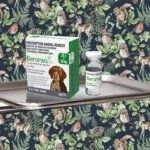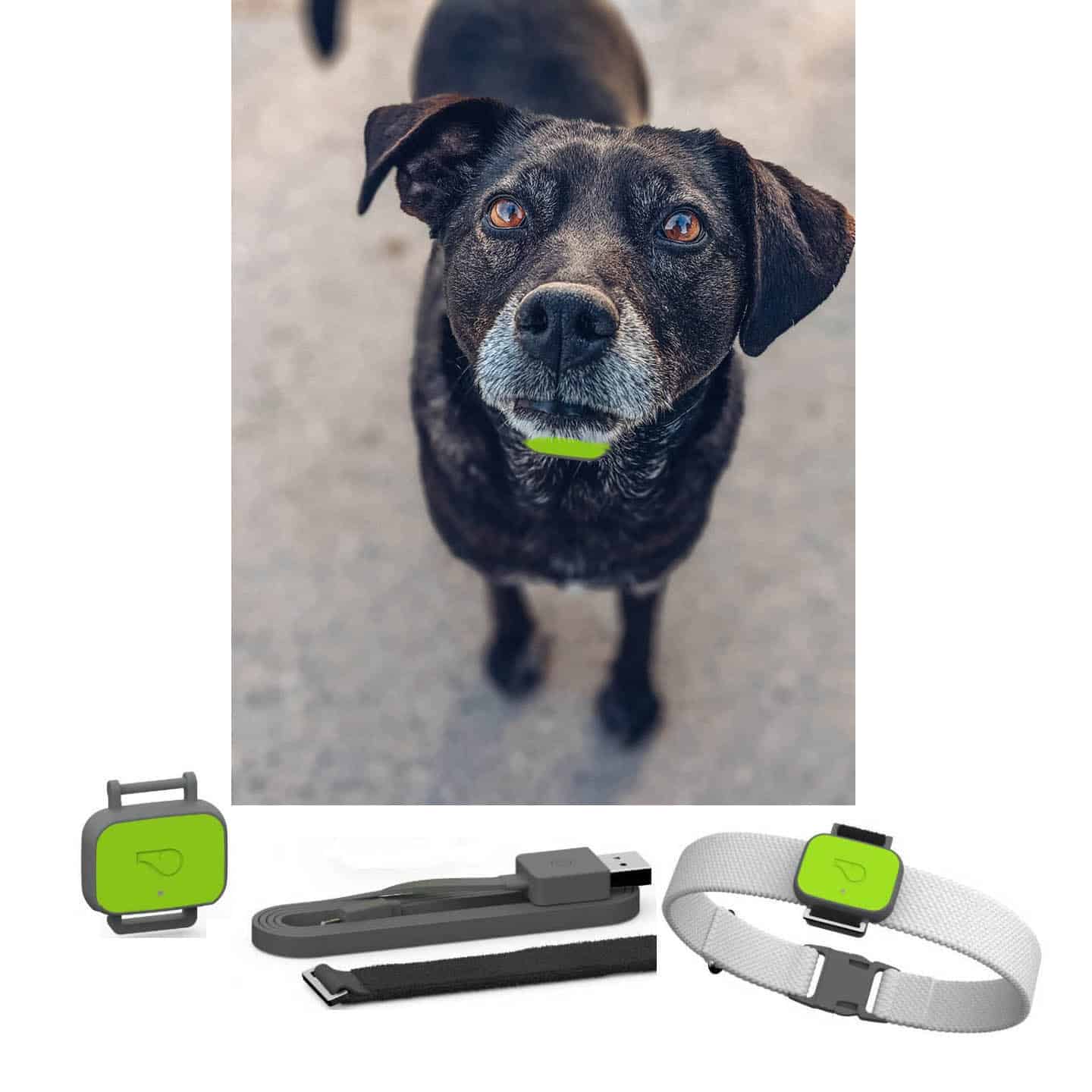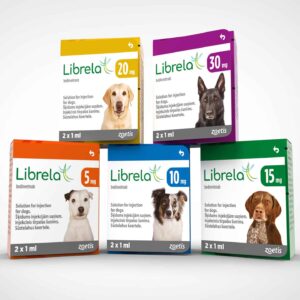Librela®, A New Approach To Arthritis Pain In Your Dog
Ron Hines DVM PhD
 Librela® Dog Owner Feedback Page
Librela® Dog Owner Feedback Page
 Dealing With Joint And Back Pain In Your Older Dog
Dealing With Joint And Back Pain In Your Older Dog
 Cat Owner Feedback On Solensia®
Cat Owner Feedback On Solensia®
 In Australia Librela is or was Beransa®
In Australia Librela is or was Beransa®
In a small USA trial, 47.4% of dog owners whose pets took Librela® (bedinvetmab) injections monthly for arthritis thought it might have been helpful to their pet in reducing its arthritis pain. But 36.6% of the dog owners whose dogs received placebo injections thought their dog improved too. (read here) So through 2023, I believe that Zoetis did not find the drug spectacular enough to be profitable in the United States (at least I couldn’t bring it up for purchase through my Zoetis account). Prior to marketing, companies like Zoetis usually make sure that their produce, in this case bedinvetmab, has a Wikipedia page. Through 3/13/23 there was none. To the best of my knowledge, in 2023 it was available in the UK and mainland Europe. I may be incorrect in some of my assumptions because I have no access to Zoetis’s internal decision making process.
This article about Librela repeats much of what you will find in another article of mine that concerns a very similar Zoetis anti-nerve growth factor (NGF) for arthritis pain management in arthritic cats, Solensia®. Solensia has been on the US market much longer. You can read some cat owner’s experience with that Solensia here. Because cats, are genetically, psycologically and metabolically quite different from dogs, you cannot assume that the benefits or hazards of the two drugs will be the same in both species. But both drugs are basically the same anti-nerve growth factor medication. It is just that the cat product, Solensia®, had to be bioengineered (“felinized”) to work in cats and Zoetis’ canine product, Librela®, has been bioengineered (“caninized”) to work in dogs. All MAB drugs like these are species-specific.
More About Librela
As I mentioned, Librela® is a new treatment option for your dog when it inevitably develops age-associated joint pain. Nothing lasts for ever and canine joints are no exception. With time, your dog’s cushoning and protective joint cartilage , composed of chondrocytes and the cartilage they produce stiffens in texture and loses its cushoning ability. The thickness and water content of the cartilage decrease and its joint lubricating ability decreases as well. Those changes eventually result in inflammation of the underlying bones that compose the joint. (read here) Bone erodes at pressure points, joints remodle in ways that encourage inflamation and pain. Dogs develop these problems at different ages and to different extents. An accident or repeated trauma to specific joints might make arthritic pain appear in those joints at a quite early age. Working dogs are apt to develop arthritis in the joints their work stresses the most. Breed conformation is very important as well. Dogs with body conformation quite different from primordial breeds may be cute to look at. But their breed cuteness comes at quite high a cost when it comes to health and longevity. Being larger-than-life for a breed is apt to bring blue ribbons and best of show. But that all comes with a price as well. (read here) Being overweight hastens the stress on a dog’s joints as well. Your dog will do most anything for you because it loves you. But please do not ask it to do physical things that will hasten arthritis pain.
No medication that is effective in lessening the pain of arthritis is free of potential side effects. The most common effective ones veterinarians dispensed to dogs were Rimadyl, Previcox and Galaprant. Some vets dispense gabapentin, a drug originally dispensed as a treatment for epilepsy. Its effects on blocking arthritis pain are debatable.
put that all NSAIDs decrease the inflammation that is the underlying cause of pain. Librela does not decrease joint inflammation. It block the nerves that trasmit joint pain to the dog’s brain
https://en.wikipedia.org/wiki/Gabapentin#Veterinary_use
Stopped
However, in March of 2020, the FDA did agree to consider Pfizer’s request to approve tanezumab, the “humanized” form of the same anti-nerve-growth factor (NGF) that is in Zoetis’ Librela® and Solensia®. Tanezumab was offered to the FDA as a non-narcotic option for the treatment of knee and hip arthritis pain in people. However, both the FDA and the EMA refused to approve the human product based on a prior study in which patients that took the drug needed knee and hip replacements sooner than similar patients that did not take it. It is not clear if their joint deterioration was due to a decrease in pain that allowed them to use the joint too vigorously or if the drug itself caused the problem in some other way.
The bar for new animal drug approval is set lower than it is for drugs that are intended for use in humans. Never expressed or insinuated – but perhaps in their minds, “let’s give the dog and cat versions a go first and see how that turns out”.
Do Veterinarians Need Better Chronic Pain Control Medications For My Dog Than They Have Now?
Yes, we do.
We veterinarians have the same tools today that your physician has to treat arthritic and other chronic pain in you:
Veterinarians can give your dog NSAIDs like carprofen (Rimadyl®), firocoxib (Previcox®), grapiprant (Galliprant®) or meloxicam (Metacam®) to decrease its joint inflammation pain. Most dogs handle those drugs reasonably well. But side effects can occur that include gastrointestinal irritation, vomiting, a drop in appetite and diarrhea. Other than meloxicam (Metacam®) physicians prescribe different but similar NSAIDs to their patients.
We can give your dog corticosteroid injections or corticosteroid pills such as prednisone that are potent blockers of chronic joint inflammation and the pain that produces. However, corticosteroids also have side effects that include weight gain, fluid retention, excessive thirst and urination, panting, increased susceptibility to infections, Addison’s disease upon withdrawal, etc.
Some veterinarians dispense narcotics like tramadol for pain, or even fentanyl (Duragesic®) patches when nothing milder is effective anymore. Others hope that gabapentin (Neurontin®) will provide sufficient pain relief for your dog. Fentanyl is probably helpful, but the effectiveness of the last two have never been validated.
There are veterinarians who suggest acupuncture, homeopathic remedies and “alternative medicine” for the control of pain in your dog. But there is really no scientific evidence that any of those things actually work – in pets or humans. (read here & here) Other vets suggest therapeutic laser therapy as an alternative to traditional physiotherapy. And still others suggest mood-altering drugs like amitriptyline or imipramine based on their use in treating human fibromyalgia. None of these are likely to do your dog any harm when given under veterinary supervision; but I personally have no faith in any of them. Giving your dog extra time, love and affection and altering its lifestyle to deal with its disabilities is likely to do it considerably more good than mood modifying drugs designed to treat depression.
What Is Nerve Growth Factor (NGF) And How Does It Relate To My Dog’s Arthritis Pain?
Nerve growth factor is a small, protein-like molecule that individual nerve cells (neurons) use to communicate with each other. NGF helps determine which neurons survive and prosper (read here) and has more recently been found to have a host of different functions within the mature body ranging from insulin secretion from the pancreas (read here) to allergic inflammation. (read here) Librela® should cause your dog to have less NGF in its system. That could mean less arthritis pain, but we know very little about what else might occur. In all species, the functions of NGF are different during embryonic development and growth than they are in adults.
The nerve highway through which signals travel in you and your dog is a two-way street. Some nerve signals travel from the brain to the far ends of its branches throughout the body to tell cells there what to do (motor neurons). Others travel in the opposite direction, from the fine ends of its branches throughout the body to the brain to communicate cold, warmth, taste, feel, smell, etc. Those are called sensory neurons. The finger-like ends of some sensory neurons appear to only sense pain. (read here)
By 2006, it became known that blocking the effects of NGF blocked pain. (read here) The Pfizer and Lilly drug companies invested $550 million dollars into their research on tanezumab anticipating that a successful human NGF-blocking medications would have a $1.23 billion dollar market. All the drugs that were contemplated were monoclonal antibodies (mAb’s) – protein “smart bombs” carrying “payload” antibodies that seek out and disable in theory only one compound within the body. As I mentioned at the beginning of this article, the Pfizer’s compound, tanezumab, has unresolved issues. But one veterinary mAb that did make it to market several years ago is Zoetis’ Cytopoint®.
What Do Studies Tell Us About The Effectiveness And Safety Profile Of Medications Similar To Librela®?
The basic science behind Librela® appears valid, and it would be wonderful if Librela® turns out to be an unqualified successes. But it is impossible to predict that based on the Zoetis-sponsored studies that have been released to the public so far. Lavish drug company publication-funding made it harder and harder for people like me to determine the true worth of medications and procedures across the entire spectrum of veterinary medicine. There is no doubt in my mind that purse string control influences study outcomes. (read here, here & here)
Where Can I Find Unbiased Information Regarding Librela®?
For a start, try the Dog Owner Librela® Feedback Page
If you follow that link, I need to begin with an observation that people whose pets experience unexpected unwanted side effects from a medication tend to report them to me more frequently than those who were satisfied with their pet’s experience using a drug. That has been found to be the case with human drugs as well. You can see that in my webpage that concerns another Zoetis mAb product, Cytopoint®. However, the Dog Owner Librela® Feedback Page is a good place to start. Nobody’s thumb is on the scale there.
Other unbiased online sources of information will be harder for you to find. As of March 2023, Wikipedia has no page on bedinvetmab (Librela®). When they eventually do, it will probably be created by or at the behest of Zoetis. That is quite legitimate. But you won’t find links to this, or any of my other articles there.

What About The Dog Owner Surveys That Zoetis Conducted?
Pet Owner opinion has been found to be an unreliable way to measure drug effectiveness. In one of Zoetis’ studies of Solensia®, the sister “felinized” equivalent of “caninized” Librela®, 67% of cat owners whose cats received the placebo injection thought that their cat had improved after its injection too. That wasn’t much less than the number that thought their cat’s pain had lessened after the real injection.
It’s just our human nature to try to maintain a positive attitude and hope for the best. (read here & here) Activity monitors, like the one on the 12-year-old Labrador cross in the photo above, are really the only valid way to judge the effectiveness of any pain-control medication you give to your dog or cat. (read here)
Other than through the use of activity monitors, veterinarians and dog owners have no accurate way to measure arthritic pain levels in dogs. And even then, there are major limits to its accuracy. Just like you, your dog can become reluctant to move for a plethora (=a very large number) of reasons that have nothing to do with its joints. You know your dog best. Go with your instincts.
Joint x-rays are also unreliable indicators of pain. Studies have shown that only ~50% of people over the age of 65 that have x-ray evidence of arthritic knee joint changes experience any knee pain. And those that have joint pain do not necessarily have x-ray evidence of arthritis. As for hip pain, only 9.1 – 15.6% of people that experienced hip pain had any x-ray evidence of hip arthritis. And of those that did have evidence of hip arthritis, only 20% reported frequent hip pain.
Acute pain, such as from a cruciate or elbow ligament tear or a disc injury, can have positives as well as negative effects. Pain decreases motion, and your dog’s reluctance to move and the inactivity that provides gives its body a chance to heal.
Older dogs and old cats often have kidney health issues. (read here) That might lead your veterinarian to consider dispensing Librela® to your elderly pet on a risk-to-benefit basis. We do not know how or if lowering your dog’s NGF level affects its kidneys. But there is an interplay. (read here & here)
There are other questions yet to be answered regarding the long-term benefit of Librela® in reliving chronic arthritis pain in dogs. When laboratory rats were given injections of mouse nerve growth factor in an attempt to produce antibodies against NGF similar to what Librela® does, the rats did produce anti-NGF antibodies. However, that had deleterious effects throughout their nervous system. (read here) That study was performed long ago. Perhaps it was accurate; perhaps it wasn’t. Perhaps Zoetis keeps its recommended monthly dose low enough to avoid this problem or perhaps dogs do not react in similar ways to rats.
Another unknown is if dogs receiving an mAb such as Librela® after multiple monthly injections learn to recognize that it is foreign to their body and destroy it. If so, will the drug lose its effectiveness over time? There are instances of that occurring with therapeutic mAbs, it is called loss of response or LOR. (read about that here) Hopefully that will not be the case.
Before Your Dog Receives This Product:
When Librela® becomes available where you live, Please read the entire label online because there might be more warnings I did not mention and because the label directions may have changed by the time you read this article.
You are on the Vetspace animal health website
Visiting the products that you see displayed on this website help pay the cost of keeping these articles on the Internet.



